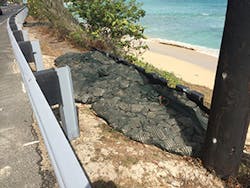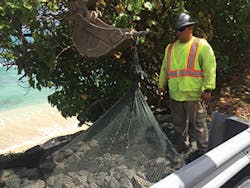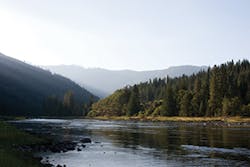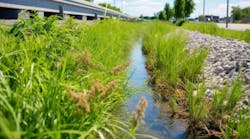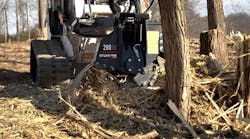Hard-armor products are valuable tools in the tool chest of experts in erosion control and stormwater management. For some applications, softer alternatives such as erosion control blankets, turf reinforcement mats, and vegetation are appropriate. But many roads, bridges, and streambanks face destruction because of undercutting due to runoff or high water, and these situations require different solutions. Sometimes the combination of hard armor and the softer choices are the best solution. For example, hard armor might be installed along the streambank to above water level with erosion control blankets and vegetation stabilizing the top of the bank.
Another place where armor can be an excellent choice is replacing the old standby concrete lining along a creek or river. Concrete lining was the standard application decades ago. It has the strength required, but also increases water speed, leading to scouring and erosion farther downstream. Many jurisdictions now try to replace concrete whenever possible. In addition, many of those old concrete linings are deteriorating and need replacing.
In most of the country, the trend is toward more natural streambeds, so armor products that blend in are highly desired. Nearby residents often prefer a more natural look, something that looks like a natural creek. In some cases, a creek bottom may be left natural while the banks have armor installed for protection against scour and erosion.
Armor products have the advantages of stability and endurance. Some have more flexibility for covering uneven ground; others have increased resistance to shear forces, and some are better suited for spot treatments to protect an area from erosion. This article covers some examples of successful projects.
Hawaiian Highway
The scenic Kalaniana’ole Highway along Hawaii’s coast was threatened with collapse into the ocean. The highway is built into sea cliffs that rise sharply from the beaches. A drive along the road offers unparalleled views from Oahu’s south shore. The islands of Maui, Molokai, and Lanai are visible on clear days. One lookout point features the Halona Blowhole where seawater bursts up through a hole in a lava shelf, and another view overlooks Eternity Beach where the movie From Here to Eternity was filmed in 1953.
Runoff from the two-lane highway was eroding and undercutting the shoulder at four locations, threatening a collapse of the road at these points. Hawaii Department of Transportation officials knew that a stabilization project was needed to protect the integrity of this vital road. The project would have to stop the erosion, provide support to the roadway, and expedite revegetation of the slope down from the highway to the beaches.
The product chosen has been used extensively in Japan and Europe, but it is fairly new to the US. Kyowa Filter Units, distributed in North America by Marubeni America Corporation, were originally developed in 1987 during construction of the Akashi Kaikyō Bridge in Japan. At the time, the bridge was the longest central span suspension bridge in the world at 12,831 feet. Filter Units were envisioned, manufactured, and installed to prevent major channel bed scour around the support towers and to provide easy deployment and positioning even in strong currents. Once the construction was finished, riprap would be installed, and the Filter Units would provide long-term filtering under the riprap.
After 30 years of service, the Filter Units around the bridge supports have met and exceeded their design specifications. They have since been installed in numerous projects throughout Japan and Europe. More than 700,000 Filter Units have been installed in Japan.
Filter Units are bags made of a polyester fiber mesh, which can be filled with local rock. The mesh does not rust or release toxic pollutants, and it does not degrade when immersed in saltwater or in highly acidic or alkaline soils. It is treated with a dye so it also withstands UV exposure for up to 30 years. The total unit is flexible and so conforms to the shape of the underlying soil. The spaces within the unit can provide habitat for aquatic organisms.
For the Hawaiian highway, 30 Filter Units were placed in four locations. The mesh bags were draped into a production box, and rocks approximately 50 millimeters in diameter were poured into them with a loader. The mesh size is 25 millimeters, and each bag has a volume of 1.25 cubic meters. The rock for this project was locally sourced basalt. It was brought in by truck, and the bags were filled at the project site. Once the bags were filled, a binding rope was closed on each bag. Multiple bags can be linked together with a rope. Each Filter Unit comes with a cast iron ring, which connects to the fastening points of the net lifting rope. This ensures safety and accuracy in lifting and placing the bags. The rope is pulled upward to allow the bag to be picked up and placed with a backhoe.
Supports were installed at the bottom of the area to add extra support for the Filter Units in case it was needed on the steep slopes. The weight of the Filter Units allows them to stay in place in swiftly moving current or on slopes, so extra supports are not usually needed.
The project required a backhoe operator and a two-man placement crew. The entire project of placing the units on the four locations was completed in one day and caused only minimal traffic impact on the busy highway.
This project was so successful that an even larger project is under construction in Hawaii. The company hopes to expand the use of the Filter Units in the US.
Canadian Lake
A roadway adjacent to Kenosee Lake in Moose Mountain Park, Saskatchewan, was also at risk of collapse. Rising water levels in the lake had caused severe erosion and undercutting of the road. The Ministry of Highways and Infrastructure developed and engineered a plan to repair the damage and prevent reoccurrence.
The product chosen was Cable Concrete, an articulate concrete block system manufactured by International Erosion Control Systems. The concrete blocks are attached to each other with cables. The type 302/304 stainless steel aircraft cables are manufactured into the block during pouring. The cable attachments give the mat the flexibility to conform to the contours of the underlying ground and still provide the stability of concrete. Stainless steel cable clamps can be used to connect adjoining mats to cover a large area in flows exceeding 10 feet per second.
Four thicknesses of blocks are available, from 4 to 9 inches. Each block weighs from 37 to 78 pounds and has a square top face of 11.5 inches and a square bottom of 15.5 inches. The difference in size from top to bottom allows the block to articulate from 20 to 60 degrees, depending on the block size. This makes the connected mat more flexible. Earth anchors can be added if needed for more stability, especially in rapid water flows.
Cable Concrete can be used for both pedestrian and vehicle traffic. This makes it a valuable product for crossings over creeks and rivers.
The interconnected blocks come as large mats and are delivered to the job site ready for installation. The air-entrained concrete provides durability and freeze-thaw resistance. Each mat has cable loops to make easy connections between mats or additional anchoring as needed. The system has 20 to 40% open area, giving water permeability and promoting vegetation growth. Block sections can be cut from the mat to cover smaller or irregular areas.
The Cable Concrete mats were placed at the edge of Kenosee Lake, with some sections partially submerged in the water, and along the edge of the road. About 16,000 square feet or 100 mats were installed.
Installation went very well. The erosion has stopped and the road has been saved, even if water levels in the lake rise further.
Clearwater River
Idaho Bridge
US Highway 95 passes over Clearwater River on the 1,200-foot Spalding Bridge near Lewiston, ID. The highway is a main connector for this region, so the stability of the bridge is vital. Since construction in 1962, the Spalding Bridge has been one of the top 10 most scour-critical bridges in Idaho. Several of the bridge’s eight piers had been undermined or were in danger of being undermined. The bridge was in desperate need of stabilization and protection.
The Idaho Transportation Department began a project for stabilizing Spalding Bridge in August 2014. The engineering design was handled by Ayres Associates and ITD Engineering; the contractor was West Companies.
A-Jacks concrete armor units were the product of choice for the project. A-Jacks are manufactured by Contech Engineered Solutions. Their interlocking design allows them to form a flexible, scalable permeable matrix. Each A-Jacks unit has six arms extending from a center with supports between the arms. When in place, the unit rests on three legs while the other three interlock with nearby units, forming a monolithic structure. Their design allows them to dissipate energy and resist scour even in fast-flowing waters. They can be installed individually or in a pattern depending on the needs of the site. They have a void space of about 40%, giving plenty of space for fish and other marine life.
The units come in a variety of sizes. Each AJ-24 unit is 2 feet long and 1.5 feet high and weighs 78 pounds.
A-Jacks were placed around the bridge piers to shield them from further erosion. In total, 14,982 units were installed. A major difficulty arose from the flow rate of the river and the environmental sensitivity of the site. The river was measured as flowing at 12,900 cubic feet per second. This section of the river is habitat for several threatened fish species, which are also a source of food for the local Nez Perce tribe. These factors meant that the river could not be diverted during placement of the A-Jacks units. Reed Hollinshead, public information specialist with the Idaho Transportation Department, says, “Research indicates that voids in the mats provide a support system for the river gravels and help to promote fish habitat. Fish, particularly steelhead and salmon, are a vital part of the local ecosystem and needed to be protected during critical bridge safety work.”
The solution was to complete the installation in the water. The A-Jacks units were placed under the water using an excavator on a barge pushed by a tugboat. Sections of the units were installed in water depths from 4 to 14 feet and water flow measurements of 6 to 12 feet per second.
It was determined that pier 7 of the bridge was severely undermined. It would have likely failed in the near future, putting the bridge and this vital highway connection in jeopardy. With the completion of this installation, all of the bridge is secure and the marine wildlife can continue to thrive.
The project was finished in 29 working days and well ahead of a deadline set by NOAA Fisheries. Turbidity limits were not exceeded, and the cost came in $30,000 under the estimate.
The project was the winner of the 2015 AASHTO President’s Transportation Award and named an AASHTO Innovative Initiative for technologies used by state transportation departments.
Design and Plan
When designing and implementing a project to save a streambank or prevent undercutting of a road or bridge pier, consider the advantages of these different hard armor techniques. Here are some ideas for designing a project specifying hard armor.
- Measure water velocity and the grade of slope.
- Decide if flexibility is more important than having a large surface, such as a mat would provide.
- Plan softer products, such as erosion control blankets, to complement the hard armor, if needed.
- Pick vegetation that can grow with or through the hard armor choice.
- Find a supplier of rock or armor product and decide if the gabions can be filled onsite or trucked.
- Decide what equipment and crew strength will be needed.
Whatever kind of project you may attempt along a stream, river, or roadway, hard armor products will likely be a good choice. These solutions fit a variety of situations and are adaptable to wet or dry environments.
